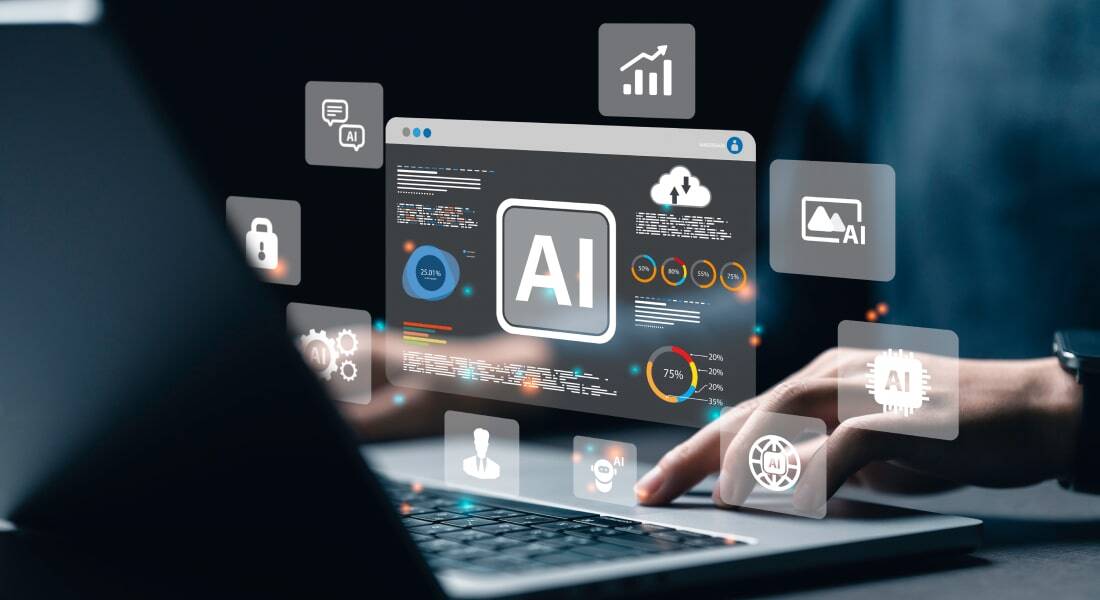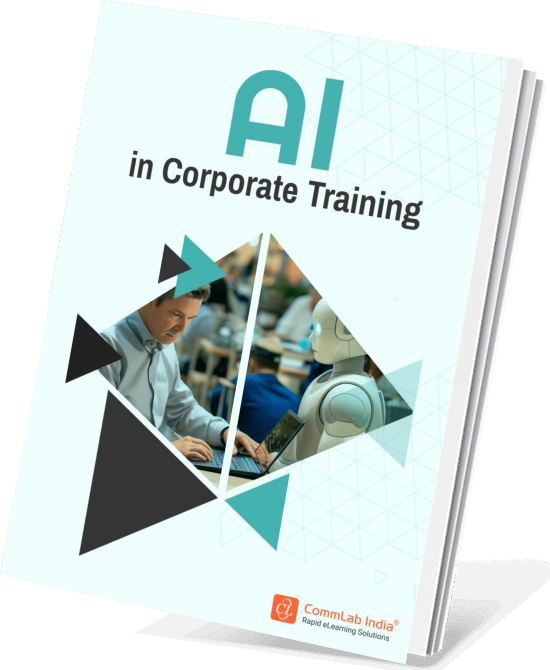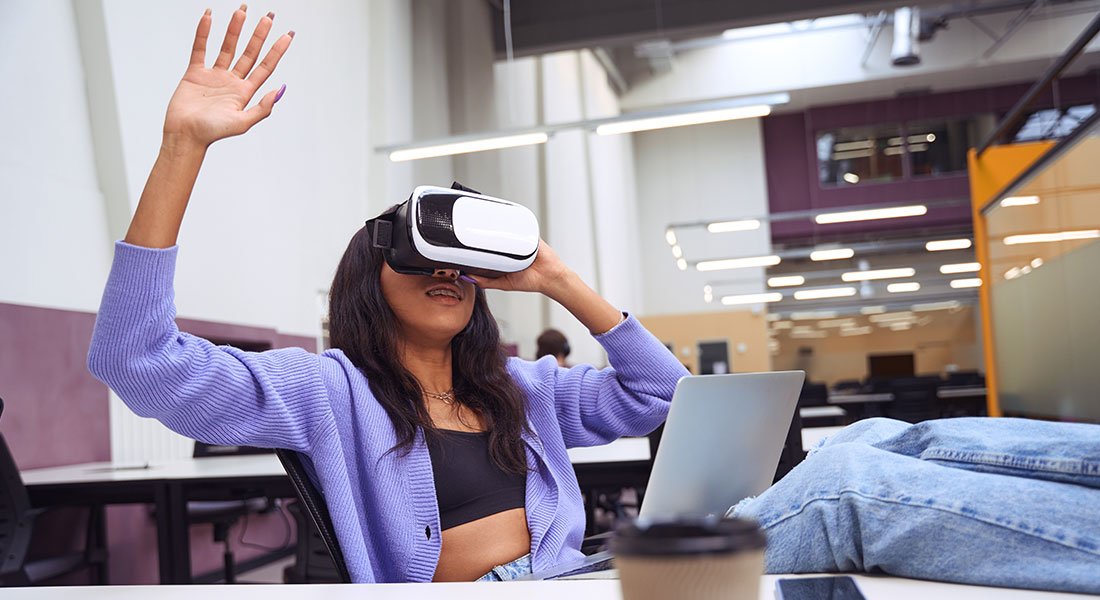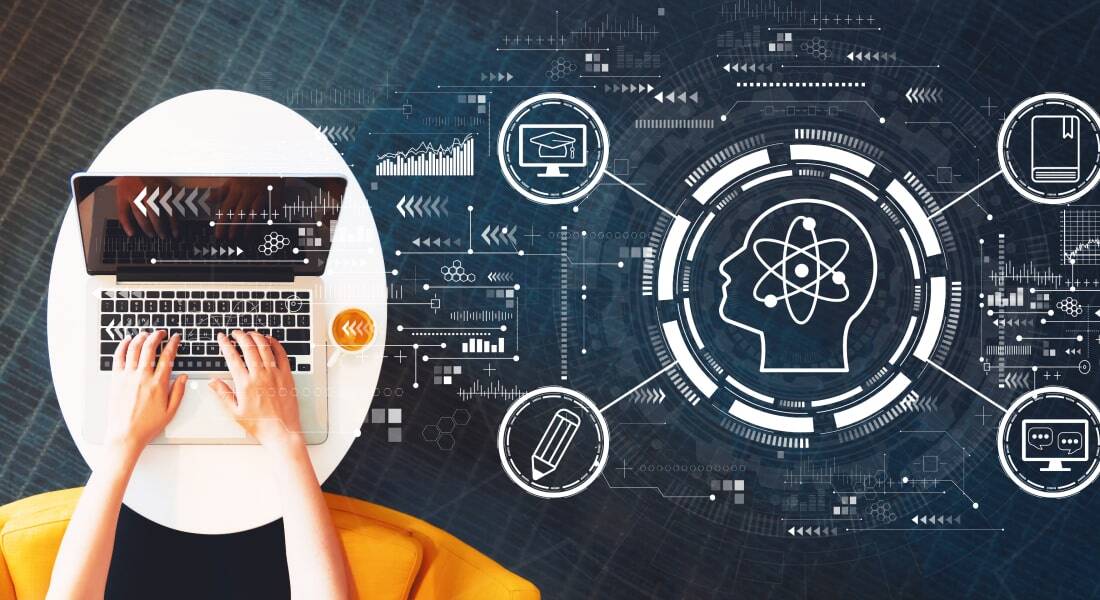Instructional Design in the Times of AI – Possibilities and Challenges

The relentless march of Artificial Intelligence (AI) is reshaping the world as we know it. From self-driving cars to medical diagnostics, AI's influence is pervasive and profound. The field of corporate training, and specifically instructional design, is no exception. As AI technologies continue to advance at a breakneck pace, instructional designers are presented with a unique set of opportunities and challenges. This blog post explores the transformative potential of AI in instructional design and how it can revolutionize the way we create, deliver, and assess eLearning experiences.
→ Download eBook Now: AI in Corporate Training
Table of Contents
- What is AI's Transformative Impact on Instructional Design?
- How AI Reshapes Various Aspects of Instruction Design?
- What are The Challenges of AI in Instructional Design?
- What is The Future of Instructional Design in the AI Era?
What is AI's Transformative Impact on Instructional Design?
Artificial Intelligence, once confined to the realm of science fiction, is now a tangible force driving innovation across numerous fields. Instructional design in custom eLearning stands at the cusp of a profound transformation, as AI-powered tools and technologies are reshaping the way we conceptualize, develop, and deliver learning experiences.
1. AI-Powered Personalization: Tailoring Learning to the Individual
One of the most exciting possibilities of AI in instructional design lies in its ability to personalize learning experiences on an unprecedented scale. Traditional one-size-fits-all approaches to training are gradually giving way to AI-driven systems that adapt to individual learners' needs, preferences, and learning styles. By analyzing learner data, including their performance, engagement, and behavior, AI algorithms can generate personalized learning pathways, recommending specific content, activities, and eLearning assessments that optimize eLearning outcomes. This tailored approach not only enhances learner motivation and engagement but also enables learners to progress at their own pace, fostering a sense of ownership and empowerment over their learning journey.
2. Intelligent Tutoring Systems: The Virtual Mentor
AI is also revolutionizing the way we provide guidance and support to learners. Intelligent tutoring systems (ITS), powered by AI algorithms, are designed to emulate the role of human tutors. These systems offer real-time feedback, adaptive scaffolding, and personalized hints, guiding learners through challenging concepts and tasks. The ability of ITS to provide individualized support at scale has the potential to bridge the gap between traditional classroom instruction and one-on-one tutoring, democratizing access to personalized learning experiences.
3. Automation of Routine Tasks: Empowering Instructional Designers
Beyond enhancing learning experiences, AI is also streamlining the instructional design process itself. By automating routine and time-consuming tasks such as grading, content creation, and administrative work, AI frees instructional designers to focus on more strategic and creative aspects of custom eLearning. This newfound efficiency not only supports instructional designers but also complements instructional design training by enabling them to spend more time crafting innovative learning activities, conducting in-depth learner analysis, and continuously iterating on their designs.
4. Data-Driven Insights: Informing Design Decisions
AI's capacity to collect and analyze massive volumes of learner data opens up new avenues for data-driven instructional design. By identifying patterns, trends, and correlations within learner data, AI can provide valuable insights into learning behaviors, preferences, and areas of difficulty. These insights can inform the design of more targeted and effective learning experiences, ensuring that instructional content and activities are aligned with learners' needs and optimized for maximum impact.
Here’s a short video to learn more about the impact of AI in L&D.
How AI Reshapes Various Aspects of Instruction Design?
Curious About How AI Will Change Instructional Design?
Here are a few aspects it will reshape
- Assessment and Feedback
- Content Creation
- Virtual and Augmented Reality Learning Environments
- Learning Disabilities and Special Needs
AI in eLearning Assessment and Feedback: Redefining Evaluation
Artificial intelligence is set to transform the landscape of eLearning assessments and feedback, offering unprecedented opportunities to streamline evaluation processes, provide personalized insights, and empower learners to take ownership of their growth. Before we start, here’s an infographic highlighting the top 5 AI tools for curating effective eLearning assessments.
Automated Grading: Efficiency and Consistency
Automated grading systems powered by AI could transform how trainers assess learner assignments. Utilizing machine learning and natural language processing, these innovative tools can evaluate various types of work, including multiple-choice quizzes, essays, and intricate problem-solving tasks. Automated grading not only saves instructors valuable time but also ensures greater consistency and objectivity in evaluations, reducing the potential for human bias and error.
Adaptive Testing: Personalized Assessment
Adaptive testing represents another exciting frontier in AI-powered assessment. These systems dynamically adjust the difficulty and type of questions based on an individual’s responses, providing a more accurate and personalized measure of their knowledge and skills. Adaptive testing not only tailors the eLearning assessments experience to each learner but also helps identify areas where they may need additional support or challenge, enabling instructors to provide more targeted interventions.
Personalized Feedback: Fueling Growth and Self-Reflection
AI has the potential to revolutionize the way feedback is delivered, making it more timely, targeted, and actionable. AI-powered systems can analyze employee’s work and provide personalized feedback that highlights strengths, identifies areas for improvement, and suggests specific strategies for growth. This individualized feedback can foster self-reflection, encourage learners to take ownership of their learning, and promote a growth mindset.
Challenges of Fairness and Validity
While AI-powered assessment and feedback offer numerous benefits, ensuring fairness and validity remains a critical challenge. Addressing algorithmic bias, ensuring transparency in AI decision-making, and maintaining the integrity of assessment data are paramount. It is also crucial to ensure that AI systems are designed to complement, rather than replace, the expertise and judgment of instructors. By striking the right balance between AI capabilities and human oversight, we can leverage the power of technology to enhance assessment practices and empower learners to reach their full potential.

AI in Corporate Training
Partner, Not Replacement
- AI in Corporate Training
- AI Toolkit for Super-charged Learning
- Challenges to Consider with AI Implementation
- And More!
AI for eLearning Content Creation: Unleashing the Power of Personalized Learning
Artificial Intelligence is transforming the creation, curation, and delivery of training content. By utilizing natural language processing (NLP) and machine learning, AI facilitates the development of engaging, interactive, and tailored learning experiences that address the varied needs and preferences of learners.
AI-Powered Content Generation: Efficiency and Innovation
AI algorithms can now generate a wide range of learning content, from quizzes and assessments to interactive simulations and personalized learning materials. NLP enables AI to understand and process natural language, allowing it to create content that is both informative and engaging. Machine learning algorithms can analyze vast amounts of data to identify patterns and trends, enabling AI to generate content that is tailored to specific learning objectives and learner needs. This automation of content creation not only saves instructional designers valuable time but also opens up new possibilities for innovation and creativity.
Adaptive Learning Materials: Personalized Pathways to Success
AI-powered adaptive learning platforms are transforming the way learning content is delivered. These platforms leverage machine learning algorithms to analyze learner performance and behavior, dynamically adjusting the content, pacing, and level of challenge to meet individual needs. By providing learners with personalized pathways to success, adaptive learning platforms can enhance engagement, motivation, and learning outcomes.
Personalized Content Recommendations: Guiding Exploration and Discovery
AI can also play a crucial role in curating and recommending learning content. By analyzing learner data, AI algorithms can suggest relevant resources, activities, and eLearning assessments that align with individual interests, learning styles, and goals. This personalized approach to content curation can empower learners to take ownership of their learning journey, explore new topics, and discover their passions. Modern LXPs can help with all sorts of AI content recommendations. Here are a few more of its features.

Streamlining Content Development: Empowering Instructional Designers
Beyond automating eLearning content creation, AI can also streamline various aspects of the eLearning content development process. AI-powered instructional design tools can assist with tasks such as content tagging, metadata management, and accessibility compliance, freeing instructional designers to focus on higher-order tasks such as instructional strategy, learning design, and assessment. This efficiency not only reduces the burden on instructional designers but also enables them to create more impactful and engaging learning experiences.
AI in VR and AR Environments: A New Dimension of Immersive Learning
The convergence of artificial intelligence (AI) with immersive technologies like virtual reality (VR) and augmented reality (AR) is opening up exciting new possibilities for creating truly transformative learning experiences. By combining the power of AI with the immersive capabilities of VR/AR, we can create dynamic, interactive, and personalized learning environments that transcend the limitations of traditional classrooms and textbooks.
Discover how Extended Reality (XR), including VR and AR is revolutionizing corporate training by making learning more immersive, interactive, and effective.
Intelligent Guidance and Adaptive Scenarios: Personalized Learning Journeys
AI can enhance VR/AR learning environments by providing intelligent guidance and adaptive scenarios that cater to individual learner needs and preferences. By analyzing learner behavior, performance, and engagement data, AI algorithms can dynamically adjust the content, difficulty, and pacing of VR/AR experiences, ensuring that each learner receives the optimal level of challenge and support. This personalized approach to learning can foster greater engagement, motivation, and knowledge retention.
Personalized Feedback and Real-time Support: Empowering Learners
AI enhances VR/AR learning experiences by delivering tailored feedback and immediate assistance. By monitoring learners' progress and pinpointing challenges, AI provides focused recommendations and support to help learners navigate obstacles and reach their learning objectives. This real-time feedback loop encourages learners to take charge of their learning paths, cultivate self-regulation skills, and boost their confidence in their capabilities.
Realistic Simulations and Experiential Learning: Bridging Theory and Practice
AI-powered VR/AR has the potential to create incredibly realistic simulations and immersive experiences that bridge the gap between theory and practice. Learners can explore complex concepts, practice skills in a safe and controlled environment, and experience real-world scenarios without the risks and constraints of the physical world. This experiential learning approach can deepen understanding, foster critical thinking, and prepare learners for the challenges of the real world.

Examples of AI-Powered VR/AR in Employee Training:
Medical training: VR simulations can allow the medical workforce to practice complex procedures, interact with virtual patients, and receive real-time feedback from AI-powered tutors.
Engineering and design: AR overlays can provide engineers and designers with real-time information and guidance as they work on projects, enabling them to visualize and manipulate 3D models in their physical environment.
History and cultural exploration: VR experiences can transport learners to different historical periods or cultural settings, allowing them to immerse themselves in different worlds and gain a deeper understanding of the past.
Language learning: AR overlays can provide real-time translations and contextual information, helping language learners navigate new environments and communicate more effectively. Here are a few popular trends in the field of eLearning translations.

The possibilities for AI-powered VR/AR in education are endless. As these technologies continue to evolve and become more accessible, we can expect to see even more innovative and transformative applications that will redefine the way we learn and teach.
The Role of AI in Addressing Learning Disabilities and Special Needs: Empowering Every Learner
Artificial Intelligence (AI) has the potential to be a transformative force in creating a more inclusive and equitable learning system, particularly for learners with diverse needs. By leveraging AI's capabilities, we can develop innovative tools and solutions that cater to the unique requirements of individuals with learning disabilities, physical impairments, or language barriers, empowering them to reach their full potential.
AI-Powered Assistive Technologies: Enhancing Accessibility and Independence
AI is playing a pivotal role in the development of advanced assistive technologies that enhance accessibility and promote independence for learners with disabilities. These technologies leverage AI algorithms to provide real-time support and adapt to individual needs, enabling learners to overcome challenges and participate fully in the learning process. Some examples include:
Speech recognition and text-to-speech: AI-powered tools can convert spoken language into text and vice versa, facilitating communication and access to information for learners with hearing or speech impairments. As a bonus, here are a few AI tools you can use for voiceovers.

Image recognition and object detection: AI can analyze images and identify objects, providing visual descriptions and assistance for learners with visual impairments.
Gesture recognition and motion tracking: AI can interpret gestures and movements, enabling learners with physical disabilities to interact with technology and control their environment.
Personalized Learning Plans: Tailoring Corporate Training to Individual Needs
AI can also facilitate the creation of personalized learning plans (PLPs) that cater to the unique needs and strengths of learners with diverse needs. By analyzing learner data, including their performance, learning styles, and preferences, AI algorithms can generate customized learning pathways, recommend appropriate interventions, and track progress over time. PLPs empower instructors to provide targeted support and accommodations, ensuring that every learner receives the individualized attention they need to succeed.
Inclusive Learning Environments: Fostering Belonging and Participation
AI has the potential to create more inclusive learning environments that foster a sense of belonging and encourage active participation for all learners. By providing real-time captioning, translation services, and personalized support, AI can break down communication barriers and ensure that every learner has the opportunity to engage with the learning material and contribute to classroom discussions. AI-powered tools can also help instructors identify and address potential barriers to learning, promoting a more equitable and inclusive learning experience for all.
Breaking Down Barriers and Promoting Equitable Access
The integration of AI in corporate training has the power to break down barriers and promote equitable access for learners with diverse needs. By providing personalized support, enhancing accessibility, and fostering inclusive learning environments, AI can empower learners to overcome challenges, participate fully in the learning process, and achieve their professional and personal goals.
What are The Challenges of AI in Instructional Design?
While the transformative potential of AI in instructional design is undeniable, its integration is not without challenges. As we navigate this rapidly evolving landscape, it is crucial to address the ethical considerations, limitations, and potential pitfalls that accompany the use of AI in L&D settings.
Ethical Considerations: Balancing Innovation with Responsibility
The integration of AI in instructional design brings several ethical challenges to the forefront. Key issues include data privacy, algorithmic bias, and the risk of AI reinforcing current inequalities in training. As instructional designers, we hold the duty to ensure that learner data is collected and utilized in a manner that is transparent, secure, and adheres to applicable privacy laws. Additionally, we must actively combat algorithmic bias to prevent discriminatory results and perpetuation of existing inequities. It is crucial to emphasize fairness, equity, and inclusivity when creating and implementing AI-driven learning tools and technologies.
The Human Touch: Nurturing Connection and Empathy
While AI can automate tasks and provide personalized support, it cannot fully replicate the human connection and empathy that are crucial in certain learning contexts. The role of the instructor as a mentor, motivator, and facilitator of social-emotional learning remains indispensable. As we integrate AI into instructional design, we must strike a balance between leveraging its capabilities and preserving the irreplaceable human element in corporate training. t's crucial to make sure that AI functions as a tool to augment, not substitute, human interaction and connection in the learning experience.
The Digital Divide: Ensuring Equitable Access
The widespread adoption of AI in education raises concerns about exacerbating the digital divide, particularly in resource-constrained settings. Access to technology, reliable internet connectivity, and digital literacy skills are prerequisites for reaping the benefits of AI-powered learning experiences. As instructional designers, we must be mindful of these disparities and strive to create solutions that are accessible and inclusive. This may involve advocating for equitable access to technology, designing learning experiences that can be adapted to low-bandwidth environments, and providing support for learners who may lack digital literacy skills.
The Need for Upskilling: Adapting to the AI Era
The rapid pace of AI advancements necessitates continuous upskilling and professional development for instructional designers. Staying abreast of the latest AI trends, tools, and technologies is essential for harnessing their full potential and remaining relevant in the field. Embracing a growth mindset and actively seeking out opportunities to learn and experiment with AI will empower instructional designers to navigate this evolving landscape with confidence and creativity. Here are a few popular platforms for upskilling.

What is The Future of Instructional Design in the AI Era?
As AI continues its rapid evolution, the future of instructional design holds immense promise. We stand on the brink of a new era where human creativity and AI capabilities intertwine to create truly innovative and impactful learning experiences.
Collaboration between Humans and AI: A Synergistic Partnership
The future of instructional design lies not in replacing humans with AI, but in fostering a collaborative partnership where each complements the other's strengths. AI can augment human creativity, expertise, and decision-making by providing data-driven insights, automating routine tasks, and generating personalized learning pathways. This synergy allows instructional designers to focus on higher-order thinking skills, such as crafting compelling narratives, designing engaging activities, and fostering meaningful connections with learners.
AI-Enhanced Creativity: Fueling Innovation
AI has the potential to spark creativity and inspire new approaches to instructional design. By analyzing vast amounts of data and identifying patterns, AI can generate novel ideas, suggest unexpected connections, and facilitate brainstorming sessions. This approach can result in the development of more captivating, interactive, and meaningful learning experiences that address various learning styles and preferences. Imagine AI-powered tools that can create personalized simulations, generate adaptive scenarios, create eLearning videos, or even compose original music and artwork to enhance learning content.
Lifelong Learning and Adaptation: Embracing the Growth Mindset
By 2026, more than 80% of enterprises will have deployed generative AI-enabled applications.
Source: Gartner
In the AI era, the ability to learn, adapt, and evolve is more critical than ever. Instructional designers must embrace a lifelong learning mindset, continuously updating their skills and knowledge to keep pace with technological advancements. This may involve seeking out professional development opportunities, experimenting with new AI and GenAI tools, and staying informed about the latest research and best practices in the field.
Ethical and Responsible AI Implementation: A Moral Imperative
As we venture into the future of AI in instructional design, it is imperative to prioritize ethical considerations and responsible AI practices. Transparency, accountability, and fairness must be at the forefront of AI development and deployment in corporate training settings. This includes ensuring that AI algorithms are free from bias, that learner data is handled with utmost care and respect for privacy, and that AI is used to promote equity, diversity, and inclusivity in corporate training. By upholding these principles, we can harness the power of AI for the betterment of society while safeguarding the rights and well-being of learners.
Wrapping Up!
The fusion of artificial intelligence with instructional design heralds a new era of corporate training possibilities. By fostering collaboration between humans and AI, prioritizing lifelong learning, and promoting responsible AI practices, we can shape a future where learning is truly personalized, empowering learners of all backgrounds to reach their full potential. Curious to know more about the impact of AI in corporate training? Here's a free eBook to download right now and boost your knowledge!









